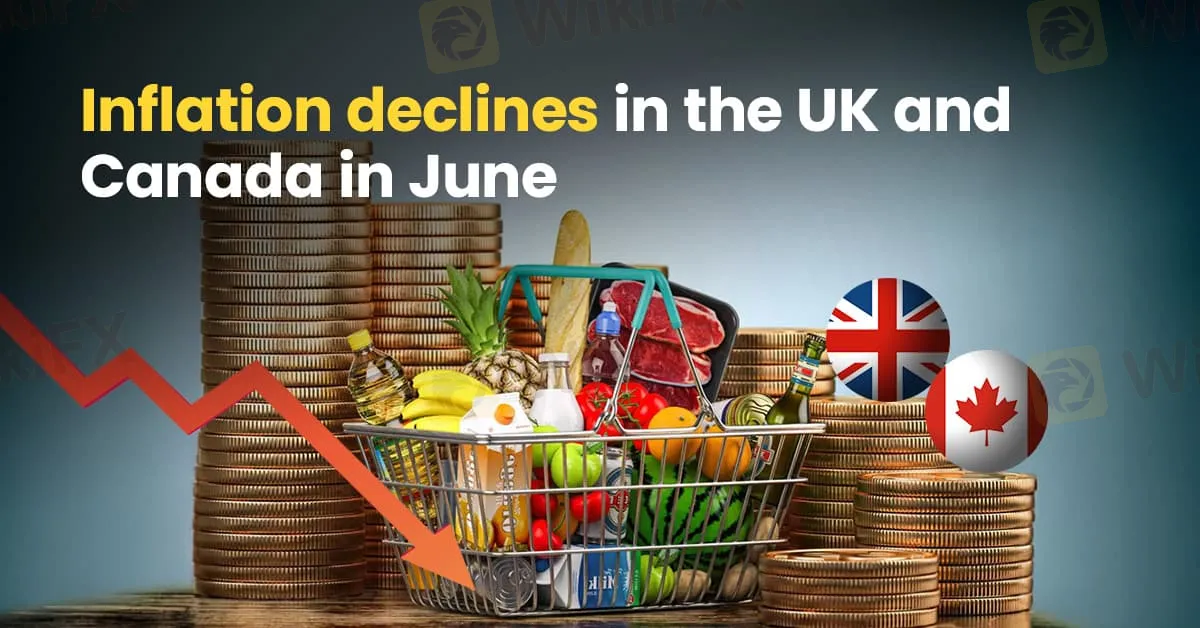简体中文
繁體中文
English
Pусский
日本語
ภาษาไทย
Tiếng Việt
Bahasa Indonesia
Español
हिन्दी
Filippiiniläinen
Français
Deutsch
Português
Türkçe
한국어
العربية
Inflation declines in the UK and Canada in June
Abstract:In June, both Canada and the UK experienced a notable decline in inflation rates. This trend aligns with the broader global movement toward lower inflation. The British Pound (GBP) rose sharply against the US Dollar (USD), while Canadian benchmark stock indices showed significant gains.

In June, both Canada and the UK experienced a notable decline in inflation rates. This trend aligns with the broader global movement toward lower inflation. The British Pound (GBP) rose sharply against the US Dollar (USD), while Canadian benchmark stock indices showed significant gains.
Inflation Falls in The UK
In the UK, a positive inflation report pushed the British Pound higher. The CPI remained at 2% year-on-year, unchanged from June, which aligns with the Bank of Englands (BoE) inflation target. Core CPI also remained steady at 3.5% year-on-year. Every month for June, CPI dropped from 0.3% to 0.1%, while core CPI eased from 0.5% to 0.2%.
However, UK services inflation remained unchanged in June at 5.7% year-on-year, nearly three times the BoE‘s inflation target. This persistent high services inflation could complicate the BoE’s plans to lower interest rates.
Inflation Falls in Canada
Canadas Consumer Price Index (CPI) rose by 2.7% year-on-year in June, down from 2.9% in May, matching a three-year low from April. Monthly, CPI posted a 0.1% decline, a sharp drop from the 0.6% increase in May. This was the first monthly decline of the year, primarily driven by a significant reduction in gasoline prices.
However, Core CPI, which excludes food and energy prices, rose by 1.9% year-on-year, slightly up from 1.8% in May. Despite this increase, it remained below the Bank of Canadas (BoC) inflation target of 2%.
Conclusion
These inflation reports indicate a continuing disinflationary trend, which supports the case for interest rate cuts. The Bank of Canada has already lowered rates in June, and it is likely only a matter of time before the Bank of England follows suit.
The USD/CAD currency pair showed little movement in response to the inflation release, while the GBP/USD pair experienced strong gains of 0.52% and 0.67% respectively following the inflation reports.
On the stock market, Canadian benchmark stock indices climbed sharply while UK indices showed a slight decline. The S&P/TSX (Canada) surged 1.07% on Tuesday, rising 243 points to close at 22,995. In contrast, the FTSE 100 (UK) fell by 28 points (0.36%) to 8,136 on Wednesday.
These developments reflect the mixed reactions in financial markets to the evolving inflation landscape in both countries.

Disclaimer:
The views in this article only represent the author's personal views, and do not constitute investment advice on this platform. This platform does not guarantee the accuracy, completeness and timeliness of the information in the article, and will not be liable for any loss caused by the use of or reliance on the information in the article.
Read more

Will Inflation Slow Down in the New Year 2025?
Will inflation slow down in 2025? Experts weigh in on projections, economic policies, and potential impacts, offering insights into what the new year may hold.

Why Is UK Inflation Rising Again Despite Recent Lows?
October inflation rises to 2.3%, driven by energy costs. Renters face 8% annual hikes, while house price inflation climbs. Interest rates stay elevated.

How Inflation Rates Affect Forex Prices Globally
In this article, we’ll explore how inflation affects forex prices globally, the relationship between inflation and currency value, and why traders monitor inflation closely.

PH Financial Sector Grows to P32.3T, Up 10.5% in June
The Philippine financial sector expanded by 10.5% in June, reaching P32.3 trillion. Bank resources surged, while positive earnings drove stock market gains.
WikiFX Broker
Latest News
Macro Markets: Is It Worth Your Investment?
Trading is an Endless Journey
What Impact Does Japan’s Positive Output Gap Have on the Yen?
RM62k Lost Investment Scam After Joining XRP Community Malaysia on Telegram
Victims of Financial Fraud in France Suffer Annual Losses of at Least €500 Million
SEC Warns on Advance Fee Loan Scams in the Philippines
Russia Turns to Bitcoin for International Trade Amid Sanctions
Rs. 20 Crore Cash, Hawala Network, Income Tax Raid in India
Hong Kong Stablecoins Bill Boosts Crypto Investments
BEWARE! Scammers are not afraid to impersonate the authorities- France’s AMF said
Currency Calculator


